For Financial Literacy, the Play's the Thing 
A theater project partially funded by a bank got teens to create a play from interviews they conducted with 80 respondents on the topic of money. Come see the play October 18.
The tooth fairy floats onstage at the high school in Somerville, Massachusetts— lanky, 6 feet tall, wearing a gold-sequined tailcoat. His face paint glitters. The audience titters.
The tooth fairy is distributing $100 bills to characters in the play. What will the lucky recipients do? Spend or save? Open a bank account or hide it under the mattress? Pay debts or give to charity? Analyze or act impulsively? These are serious questions. The giggles stop and a rapt audience settles in for the hour-long production of Money Matters.
A Play by Teens, for Teens
In 2011, Youth Underground, the student company of Underground Railway Theater in Cambridge, Massachusetts, created a play about money: spending, saving, borrowing, lending, emotions, and surprises (good and bad).
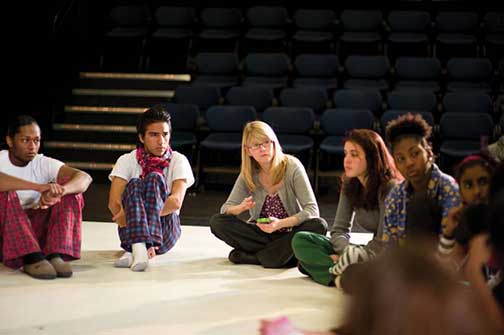
Photograph: Allan R. Sinclair
Now the student actors are touring Boston-area high schools, where they inspire students and teachers to talk about saving, spending temptations, and the idea that money means different things to different people. Cambridge Savings Bank is the sponsor.
To set the stage for a play about money, Evan Diamond, assistant vice president and financial education program manager at Cambridge Savings Bank, led financial literacy classes for the teens. In four 90-minute sessions at Cambridge Savings in Harvard Square, the students learned about budgeting and savings, credit, fraud, and managing a checking account.
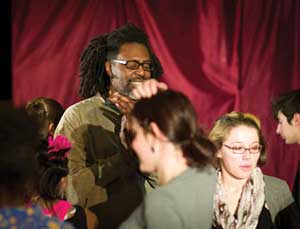
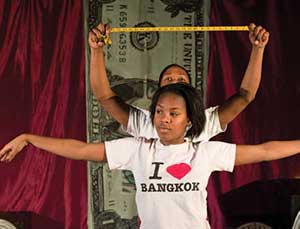
Photographs: Allan R. Sinclair
Then, working with Youth Underground teacher-facilitator Betsy Bard, they decided what they wanted to know about people and their money. In the process, they faced facts: Money issues can be awkward, and not everyone has money or wants to talk about it.
"So many kids have no idea of the economic situation of their parents," Bard says. "Kids don't know if their parents have a mortgage. They don't know if they're on a food budget."
The teens interviewed 80 people of all ages, from a third grader to grandparents. Each student conducted three taped interviews. There were group interviews, too—with a U.S. Congressman, the mayor of Cambridge, and the superintendent of schools. Brothers, sisters, aunts, uncles, grandparents, and teachers talked about money. Bankers, city workers, and other high school students all talked about money. Then, it was time to weave those stories into a play.
When the high school students shared their first memories of money, half were about the tooth fairy or its equivalent in other cultures. "It didn't matter. Haitian, Spanish, they were all talking about how they knew what their friends got and how exciting it was to hunt around under the pillow and how much they got," Bard said.
For many children, their experience with the tooth fairy was also their first realization that some kids got $20, some $5, some $1, some a quarter. "It raises questions of socioeconomic equity right away," says Maggie Moore Abdow, education director for Youth Underground. So the Tooth Fairy became Bard's organizing device, connecting the words of all the interviewees.
The Power of Storytelling
Despite the tooth fairy, Money Matters is real. The students act out the actual words of the people they interviewed. Bard calls this "investigative theater." It is modeled on the work of Anna Deavere Smith, who interviews people and acts out their words on stage.
Tapping into the power of true stories makes lessons stick, says Bard. Instead of a lecture about overdraft fees, students hear a young actor recount the story of a teen who ends up owing $105 because he bought two candy bars with a debit card. The emotional punch makes theater a powerful means of education.
"Hearing a story, you emotionally connect. It broadens your empathy. It's not just your world and your concerns and your life," says Bard. "That's developmental for adolescents, to learn that someone who looks and acts differently from them has a story they can connect to."
Other organizations use theater to teach financial concepts. For example, the Nuestro Barrio telenovela, a 13-episode soap opera targeted to Latino immigrants, contains financial literacy content, all wrapped up in a riveting plot involving a shady usedcar dealer, a robbery, and a fire.[1]
The National Children's Theater tours Mad About Money to middle schools, with the goal of teaching students about saving and spending.[2] As professional actors perform improvisational comedy sketches that incorporate details of audience members' lives—favorite musicians, best friends, inside jokes—young teens become engaged.
In Money Matters, emotions come into play—pride, envy, confidence, fear, surprise, affection. Federico Roitman, a 10th grader at Cambridge Rindge and Latin School, says that while the show teaches both actors and audience members about "the financial side" of money, "it also shows the human side of money and the emotions that come with having or not having it or seeing people with more or less money." Engaging the emotions opens the door to more traditional learning. After the show, students and their teachers may work through the Money Matters study guide to explore their own attitudes and gain understanding of concepts like debit card, fees, compound interest, payday loans, and student debt.[3]
The Youth Underground show is different from other projects that incorporate drama and financial education because the teens are in charge as creators and actors. Roitman says of Youth Underground Lead Teaching Artist/Director Vincent Siders: "His method really works with me. He wants to hear our input and hear what we think." In addition to conducting interviews and collaborating on the script, teens made portable scenery, handled the lighting, and understudied one another's roles.
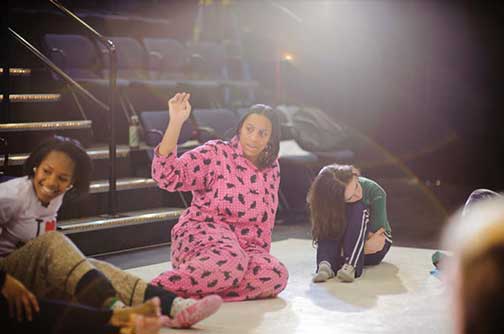
Photograph: Allan R. Sinclair
"What You Do Is Up to You"
The Cambridge Savings curriculum is organized around the concept of needs versus wants, which became an important theme of Money Matters. Bard hopes the students learn the lesson that they have a choice about what they do. The empowering message is, "What you do is up to you."
The message that people of every age have power to make choices about money provides a foundation for financial literacy. Research by William Walstad, economics professor at the University of Nebraska at Lincoln, has shown that confidence in making financial decisions is just as important as knowledge of personal finance. Walstad and Sam Allgood found that while people who are both skilled and confident are most likely to make the best financial decisions—paying their credit cards in full, for example—people who are unskilled and confident typically make better decisions than those who have knowledge but no confidence.
Feeling good about choices comes up time and again in Money Matters. Students talk about walking into a mall with a week's paycheck and leaving with "nothing"; being embarrassed when they can't pay back what they borrowed; the satisfaction of helping others. One vignette contrasts the spending choices of a teen whose parents are always handing over $20 to the habits of a teen who earns her own money. The self-supporting teen concludes that "when you pay for most things yourself, you get to make your own decisions."
Typically, adults who see the show are surprised to learn how young people spend their money. A lot of borrowing goes on. Teens spend a tremendous amount on food. "Adults have no idea how much young people spend on fashion," says Abdow. "Intergenerational audiences are fascinated by the amount of money young people spend and what they spend it on. They run to the mall, and it's gone."
Mindful Money Management
Money Matters provides a way to counteract such thoughtless spending. One sketch involves a grandparent who goes the long way round to work every day, year after year, to avoid a 50-cent toll. As the years roll by, he saves more and more money.
Abdow says, "Students think Netflix is really cheap, it's just $7.99 a month. But over five years, that's a shocking amount of money."
The student actors earn a stipend through the Mayor's Summer Youth Employment Program of the City of Cambridge. Their adult mentors at Youth Underground help them talk about the stipend, what they're spending it on, what they're not spending it on.
Roitman said that doing the show was "the first time I had money coming in. I started looking at the monologue about people going to college and thinking, 'This is how much I should save, how much I should spend.' I definitely started thinking more about the future."
In all sorts of ways, the play opens eyes to the power of money. The closing monologue is told from the point of view of a young person who visits Haiti and is embarrassed by how many pairs of sneakers he owns. The speaker donates many of his possessions and resolves to do more to help others.
Claire Greene is a payments analyst in the Consumer Payments Research Center at the Federal Reserve Bank of Boston.
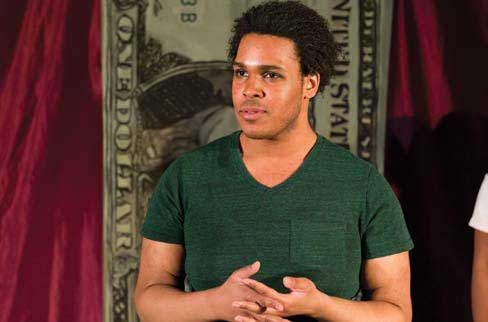
Photograph: Allan R. Sinclair
Endnotes
[1] Jonathan Spader, "The Bold and the Bankable,"
Communities & Banking 20, no. 4 (fall 2009),
http://www.bostonfed.org/commdev/c&b/2009/fall/Spader_Unbanked.pdf.
[Return to endnote in story]
[2] "Mad About Money: Schools Kids on Personal Finance,"
http://www.minneapolisfed.org/publications_papers/pub_display.cfm?id=2454  .
.
[Return to endnote in story]
[3] For a pdf of the study guide, e-mail info@centralsquaretheater.org.
[Return to endnote in story]
Articles may be reprinted if Communities & Banking and the author are credited and the following disclaimer is used: "The views expressed are not necessarily those of the Federal Reserve Bank of Boston or the Federal Reserve System. Information about organizations and upcoming events is strictly informational and not an endorsement."

 About the Authors
About the Authors
Claire Greene



